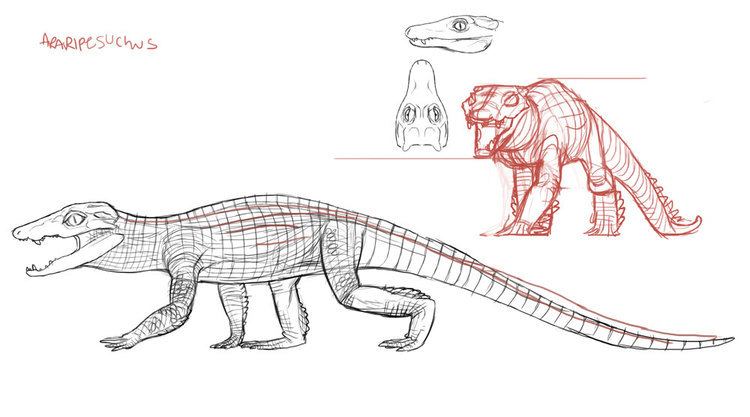Phylum Chordata | Class Reptilia Rank Genus | |
 | ||
Similar | ||
Araripesuchus is a genus of extinct crocodyliform that existed during the Cretaceous period of the late Mesozoic era some 125 to 66 million years ago. Five species of Araripesuchus are currently known. They are generally considered to be notosuchians (belonging to the clade Mesoeucrocodylia), characterized by their varied teeth types and distinct skull elements. Its length was about 1–1.8 m (3.3–5.9 ft) with a weight of 40 kg (88 lb). Araripesuchus can be distinguished by their laterally bulged edges of the snout, with the bulge being the most prominent around the area of an enlarged maxillary tooth. There are five valid species within this genus.
Contents

Discovery and history

The genus was coined in 1959 with the description of the type species Araripesuchus gomesii, a notosuchian crocodylian from the famed Santana Formation of Brazil. The holotype used to describe the genus, 423-R is currently in the care of the Divisao de Mineralogia e Geologia do Departamento Nacional da Producao Mineral in Rio de Janeiro. 423-R consists of a single skull articulating with part of a lower jaw. A more complete specimen, AMNH 24450 is held by the American Museum of Natural History. A second species, Araripesuchus wegeneri was described in 1981. This species was discovered from Early Cretaceous deposits of Niger on the African continent, as opposed to the South American paleodistribution of the other species in the genus. The type specimen for the species, GDF-700 consisting of a few, fragmentary jaw elements, reside at the Museum National d'Histoire Naturelle in Paris. Araripesuchus patagonicus was described from a patagonian specimen (MUC-PV 269) in 2000. Another species to be assigned to the genus, was Araripesuchus buitreraensis, described in 2005. This species was described from a single skull (MPCA-PV 235) retrieved from Late Cretaceous deposits in what is now Argentina. At 130 millimeters, the skull is the largest Araripesuchus specimen discovered to date. A fifth species, Araripesuchus tsangatsangana was described in 2006. This species' type specimen was discovered from latest Late Cretaceous deposits from the African island of Madagascar. Analysis of this specimen solidifies the position of A. wegneri as a member of the genus. A. tsangatsangana is the geologically youngest known of this genus.
Taxonomy

There are currently six recognized species within the genus Araripesuchus: A. patagonicus, A. buitreraensis, A. tsangatsangana, A. wegeneri, A. rattoides and the type species A. gomesii. The placement of the first African species discovered, A. wegeneri was questioned for a while by various authors. Ortega et al. argued for the assignment of the errant species to another genus based on phylogenetic analysis Further analysis, combined with the discovery of the second African species A. tsangatsangana has shed more light on the placement of A. wegeneri within the genus. When analyzed together, the African species support the inclusion of all five known species into the same genus.

The genus was originally assigned by Price to the family Uruguaysuchidae in the original 1959 description. This classification was followed by Buffetaut in 1981 with the description of A. wegeneri also within the same family. However, in their 2000 description of A. patagonicus, Ortega et al. avoided placing the species within the family. Instead, it was simply noted that Uruguaysuchus was a possible close relative of the genus.
Ortega et al. and several other studies place Araripesuchus outside Notosuchia. In some phylogenetic analyses, it is placed closer to the clade Neosuchia, which includes modern crocodilians. In most recent analyses, however, Araripesuchus is placed as a basal notosuchian. The phylogenetic analysis of Soto et al. (2011) joined Araripesuchus with Uruguaysuchus, reinstating the family Uruguaysuchidae. This family was found to be the most basal group of Notosuchia. Below is a cladogram from the analysis:
Paleoecology
Araripesuchus remains have been recovered from the continents of South America and Africa suggesting a Gondwanan origin for the evolution of the genus. At around the time of Araripesuchus existence, South America and Africa were physically adjacent to each other. The various species evolved from the same stock in the general area, radiating outward from a yet-unidentified origin point. The presence of specimens from Madagascar further strengthens this evolutionary radiation model.
